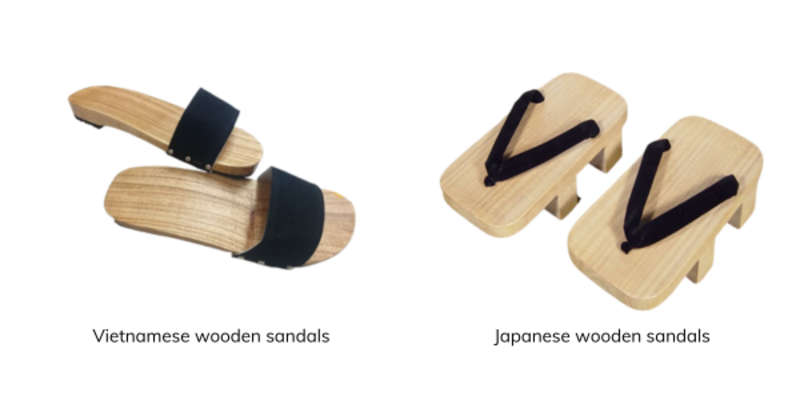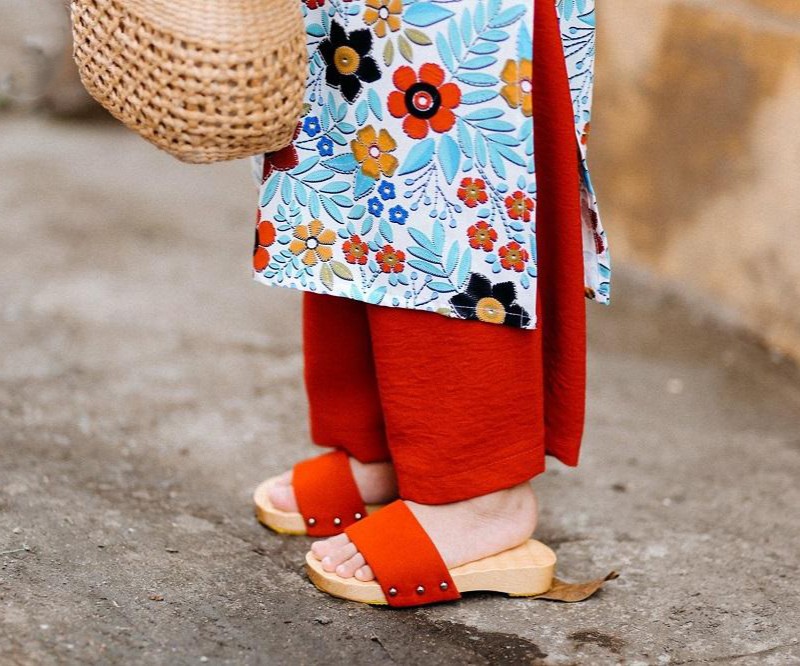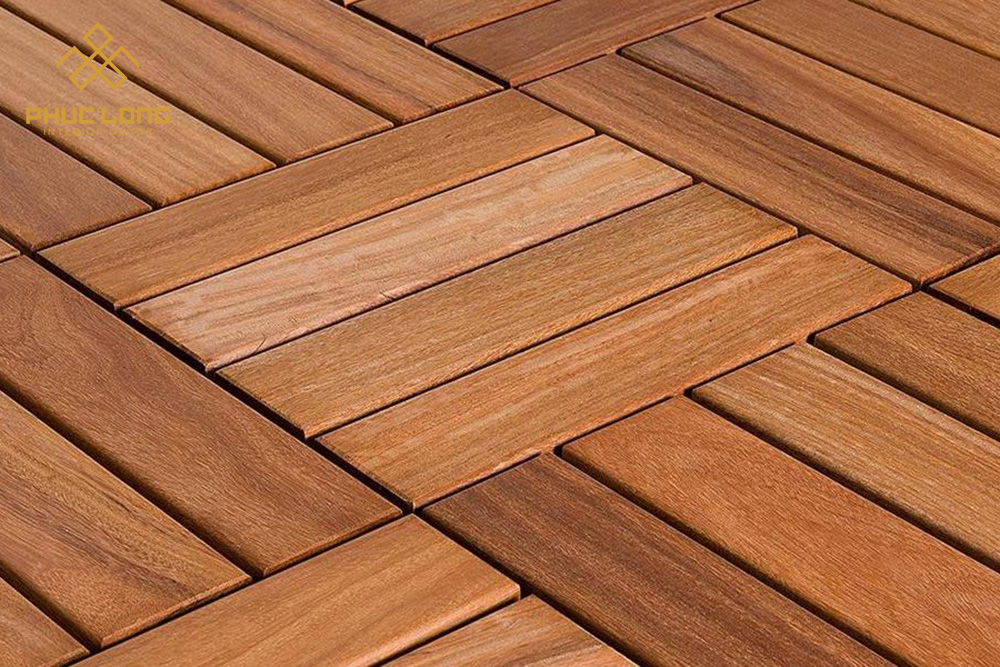Vietnamese wooden sandals have been a part of Vietnamese daily life for hundreds of years. Over time, numerous other types of footwear have emerged, seemingly replacing these traditional sandals. Nowadays, Vietnamese wooden sandals are primarily found in a few rural areas. Despite this shift, these sandals continue to embody the cultural essence they hold. Let’s delve deeper into the world of Vietnamese wooden sandals in the following article.
What are Vietnamese wooden sandals?
Vietnamese wooden sandals are traditional wooden footwear that has been worn in Vietnam for centuries. They are characterized by a simple design consisting of a wooden sole with a strap that goes across the foot to hold the sandal in place. The wooden sole is often carved with intricate patterns or designs.
These wooden sandals were historically worn by many people in Vietnam, especially in rural areas, as they were practical and suitable for navigating muddy or uneven terrain. However, in modern times, their popularity has decreased due to the availability of more comfortable and convenient footwear options.

Types of wood for making Vietnamese wooden sandals
The materials used to make wooden sandals are often lightweight and easy-to-carve types of wood, such as jackfruit, mango, coconut, agarwood, pine, etc. According to craftsmen who create wooden sandals, producing a pair of sandals involves several steps: starting from cutting and splitting the wood, then using a splitting machine; rough sanding and shaping the form of the sandals; followed by fine sanding, smoothing, and applying lacquer; the final steps involve attaching the sole and strap, or adding decorative painting based on the customer’s preferences. Here are some types of wood for making wooden slippers Vietnam Wood would like to introduce to you:
1. Jackfruit wood
Durability: Jackfruit wood is relatively durable and can resist decay and pests to a certain extent. This makes it suitable for various indoor and outdoor applications.
Texture and Grain: The wood typically has a coarse texture with a straight or interlocked grain pattern. This gives it a unique appearance when polished and finished.
Color: When freshly cut, jackfruit wood is a pale, creamy color. However, with exposure to air and light, it tends to darken and develop a richer golden hue, which can vary depending on the specific wood piece.
Workability: Jackfruit wood is relatively easy to work with due to its softness. It can be carved, shaped, and machined without excessive difficulty. This makes it a popular choice for crafting various items.
Sustainability: As jackfruit trees are commonly cultivated for their fruit, the wood can be sourced from these trees, providing an additional economic incentive for planting and maintaining jackfruit orchards.
2. Manguier mango (Mango wood)
Color and Appearance: Mango wood varies in color, ranging from pale golden to rich reddish-brown. It often features an attractive interplay of lighter and darker streaks, which can create visually appealing patterns in finished products.
Grain Pattern: Mango wood typically has an interlocked or wavy grain pattern, adding to its visual appeal. This grain pattern can lead to interesting and unique designs when the wood is crafted into furniture or other items.
Texture: The texture of mango wood is medium to coarse, giving it a natural tactile quality that can be enhanced when finished properly.
Density and Weight: Mango wood is medium-density hardwood, making it relatively easy to work with. Its moderate weight makes it suitable for both structural and decorative applications.
Sustainability: Mango wood is often considered a sustainable option as it comes from the mango tree, which is cultivated primarily for its fruit. Utilizing the wood helps make more efficient use of the tree and its resources.
3. Coconut wood
Color and Appearance: Coconut wood can vary in color, ranging from light to medium brown with occasional darker streaks. The coloration may change as the wood ages and is exposed to light.
Grain Pattern: The grain of coconut wood is typically straight or slightly interlocked, contributing to a pleasing visual appeal when used in crafting.
Texture: The wood has a fine to medium texture, giving it a smooth and polished appearance when properly finished.
Density and Weight: Coconut wood is of medium density, making it relatively lightweight compared to some other hardwoods. This makes it suitable for various applications, particularly when a balance between weight and strength is desired.
Sustainability: Coconut wood is often considered sustainable as it comes from coconut palm trees, which are widely cultivated for their fruit and other products. Utilizing wood can help minimize waste and maximize the use of the tree’s resources.
4. Agarwood
Aroma: One of the most prized qualities of agarwood is its rich, complex, and captivating fragrance. This aroma is created by the formation of resin in the heartwood as a response to injury or infection by certain fungi. The scent can vary from sweet and floral to woody, earthy, and even slightly animalic.
Color and Appearance: The color of agarwood can range from a pale golden hue to a deep, dark brown or black. The heartwood is often streaked with resinous veins, which add to its visual appeal.
Density and Weight: Agarwood is a dense and heavy wood. Its density contributes to its durability and strength, making it suitable for various applications.
Grain Pattern: Agarwood typically has a fine to medium grain with a smooth texture. This makes it suitable for carving, crafting, and creating intricate designs.
Sustainability and Conservation: The high demand for agarwood has led to overharvesting in some regions, leading to the depletion of wild agarwood-producing trees. As a result, sustainable cultivation practices and conservation efforts are being implemented to protect these valuable trees and ensure their long-term survival.
5. Pine wood
Color and Appearance: Pine wood typically ranges in color from a pale, light yellow to a light reddish-brown. It often features natural knots, streaks, and other unique characteristics that can add to its visual appeal.
Grain Pattern: Pine wood usually has a straight grain pattern, but it can also exhibit some irregularities, especially around knots. The grain can be fine to medium in texture.
Texture: The texture of pine wood is usually even and relatively smooth, making it suitable for a variety of finishes.
Density and Weight: Pine wood is generally considered a softwood and is lighter and less dense compared to many hardwoods. This can make it easier to work with but also less suited for heavy structural applications.
Sustainability: Pine trees are widely cultivated and harvested for their wood, which makes them a renewable resource. Sustainable forestry practices help ensure the long-term availability of pine wood.
Read more: What are Wood Pellets? Top 4 Vienam Wood Pellets Manufacturers
How are Vietnamese wooden sandals different from Japanese wooden sandals?
Vietnamese wooden sandals and Japanese wooden sandals are both types of traditional footwear with long cultural histories, but they have several differences in terms of design, materials used, and applications in daily life. Below is a specific comparison between these two types of sandals:
| Vietnamese wooden sandals | Japanese wooden sandals | |
| Design |
Consist of a wooden sole that is carved with decorative patterns and a strap that goes across the foot to secure it in place. The focus is often on practicality and comfort. |
Japanese wooden sandals, on the other hand, come in two main types – Geta and Zori. Geta has a distinctive elevated wooden base with two supporting “teeth” under the sole. They are worn with a fabric thong that passes between the big toe and the second toe. Zori are flat sandals with a thong strap, often made of cloth or synthetic material, and are usually more delicate in appearance compared to Geta. |
| Materials |
Vietnamese wooden sandals are typically made from lightweight and easily-carved woods such as jackfruit wood, mango wood, coconut wood, pine wood, and others. The focus is on using locally available materials that are suitable for the rural lifestyle. |
Traditional Geta often uses Paulownia wood for the base, while Zori can incorporate different types of wood and synthetic materials. |
| Usage |
Vietnamese wooden sandals are designed for everyday wear and functional tasks. They are associated with simplicity and practicality. |
Geta are often worn with traditional kimono outfits during formal events, festivals, and ceremonies. Zori can be more formal and is commonly worn with modern clothing. |

Read more: What is a Vietnamese Wooden Bed? 8 Type of Wood for Making Beds in Vietnam
The leading B2B company supplying wood for making wooden sandals in Vietnam
After being felled for use in production, the wood must be properly processed to ensure quality for the products and prevent resource wastage. Below, Vietnamwood will introduce five prominent companies that supply raw wood for manufacturing in Vietnam specifically, and other wooden products in general.
1. Minh Tam Wood – Minh Tam Wood Joint Stock Company
Minh Tam Wood Joint Stock Company is the main unit operating in the field of processing and distributing wood materials.
- Round oak, sawn oak, walnut, pine, oval, ..
- Imported from USA, New Zealand, South Africa, ..
- Veneer of Oak, Xoan, Walnut, .. on the background of laminated wood, industrial board
- Processing veneer, sawing, cutting, sawing, drying as required..
During more than 20 years of operation in the wood business, Minh Tam Wood has built a reputation with many domestic and foreign customers thanks to:
- All wood products are certified with ISO 9001: 2008 quality, classified according to the standards of the American Hardwood Association (NHLA).
- Variety of wood types and specifications along with top competitive prices
- 100% imported wood, superior quality: Fresh color, easy to process, good bearing capacity, good mold resistance
- Processing cutting, sawing, drying according to the requirements of each order.
With a team of highly skilled technical workers, modern machines, diverse and rich designs, Minh Tam Wood’s products have exported many products to countries around the world. Customers will always be satisfied with the product quality as well as the service quality of Minh Tam Wood.
2. Xuan Phu Plum Wood – Plum Xuan Phu Co., Ltd
Xuan Phu Plum Wood with 10 years of experience in distributing processed wood:
- Raw materials of rubber wood, F1 Melaleuca embryos 100% natural, unadulterated
- Extremely low ash content 2%
- Humidity, specification: according to customer requirements
- Product: No cracking, denting, warping, warping
- Competitive price, stable large quantity all year round.
The leading prestigious unit in the country specializing in manufacturing and supplying:
- Wood chips, wood chips: Fresh Melaleuca wood chips, rubber wood chips, sawn wood chips, ..
- Processing services: Wood drying services, sawing and sawing wood, processing wood chips, ..
Company’s commitment:
- Properly sawn door, according to customer’s request
- Drying to meet ISO 9001: 2008 quality standards
- Modern equipment, skilled workers.
3. Truong Gia Phuc Wood – Truong Gia Phuc One Member Company Limited
Truong Gia Phuc Wood’s main field: Supplying dried sawn rubber wood and dried sawn melaleuca, mother-of-pearl wood,…
With a dynamic, experienced team along with extensive warehouse infrastructure, abundant financial potential, the company always confident to build a good, long-term, mutually beneficial business relationship. benefits suppliers and customers.
During many years of operation, the company has gradually gone up, affirming Truong Gia Phuc brand, gaining the trust of customers through service quality, product specifications and competitive prices.
4. Hung Dai Phat Wood – Hung Dai Phat Interior Decoration Production Trading Co., Ltd
Hung Dai Phat Wood’s main fields:
- Industrial trade factory: White oak veneer, ash, cherry, peach; Coffa board covered with brown, black film, covered with clear, red glue; MDF board, moisture-proof MDF board, imported MDF board with customized sizes
- Dry wood processing and supply: Dried sawn rubber wood, dried Melaleuca wood, kiln-dried pine, kiln-dried oak, dried mother-of-pearl, processed and dried sawn timber as required,…
Their products are supplied to units, manufacturing companies, wood industry construction, construction works for the market in HCMC and neighboring provinces.
Hung Dai Phat is confident to bring customers high quality products at competitive prices.
5. A Au Wood – A Au Wood Import Export Co., Ltd
A-Au Wood is an importer and distributor of logs, kiln-dried lumber directly from reputable wood suppliers in the US, Europe, and Africa of all kinds: Walnut, ash, white oak, American white oak, European white oak, red oak, beech), pine (pine), yellow pine, white pine imported from Chile, Brazil, USA, New Zealand, Sweden , Poplar, Teak (Teak) or Gunstock), Hard Maple (Hard Maple), Soft Maple, Cherry, Alder, Mahogany/Red Wood, Saddlewood, Rosewood, Oak, Pearl Africa, Doussie Wood, Rubber Wood (Rubber), Melaleuca wood (acacia or Acacia),…
Company’s commitment:
- Wood is always available, meeting all orders from small to large quantities
- Competitive price, retail price by container

Despite having withstood the test of time for hundreds of years, Vietnamese wooden sandals continue to be utilized even in modern times. Furthermore, they serve as a living testament to the enduring cultural beauty of Vietnam. The aforementioned article has provided essential foundational information about Vietnamese wooden sandals. It covers everything from their definition and differentiation between Vietnamese and Japanese wooden sandals to the special types of wood used in crafting Vietnamese wooden sandals. Hopefully, the article that VietnamWood has successfully answered some of the readers’ questions about Vietnamese wooden sandals.





